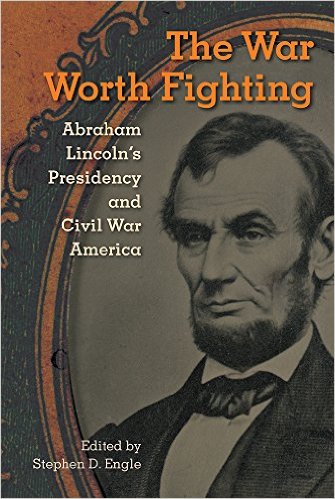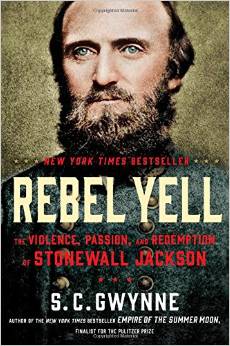The War Worth Fighting: Abraham Lincoln’s Presidency and Civil War America edited by Stephen D. Engle. University Press of Florida, 2015. Cloth, ISBN: 978-0813060644. $31.95.
 The sesquicentennial of the Civil War renewed interest in the conflict, but did not necessarily produce fresh insights into many topics familiar to scholars. Abraham Lincoln, always a popular subject, remains the heroic martyr worshipped by academic historians and the general public alike. Many of the essays in The War Worth Fighting: Abraham Lincoln’s Presidency and Civil War America, edited by Stephen D. Engle, originated in a 2013 symposium at Florida Atlantic University. Focused on the ways in which Lincoln actively shaped events both at home and abroad, the collection covers a wide spectrum of topics, ranging from military strategy to diplomacy, from the war in the North to race and slavery, from civil liberties to Reconstruction. Collectively, they argue that the beloved sixteenth president carefully crafted policies to ensure the Union’s restoration. However, this does not mean that Lincoln himself often had a sense of control, believing instead that fate ultimately shaped events.
The sesquicentennial of the Civil War renewed interest in the conflict, but did not necessarily produce fresh insights into many topics familiar to scholars. Abraham Lincoln, always a popular subject, remains the heroic martyr worshipped by academic historians and the general public alike. Many of the essays in The War Worth Fighting: Abraham Lincoln’s Presidency and Civil War America, edited by Stephen D. Engle, originated in a 2013 symposium at Florida Atlantic University. Focused on the ways in which Lincoln actively shaped events both at home and abroad, the collection covers a wide spectrum of topics, ranging from military strategy to diplomacy, from the war in the North to race and slavery, from civil liberties to Reconstruction. Collectively, they argue that the beloved sixteenth president carefully crafted policies to ensure the Union’s restoration. However, this does not mean that Lincoln himself often had a sense of control, believing instead that fate ultimately shaped events.
The first section includes a fine essay by Orville Vernon Burton that examines the nation’s evolving views on slavery, and especially the sectional religious divide that emerged. Burton’s nuanced chapter particularly focuses on Lincoln’s views of slavery, defending him from critics who view him as too moderate on racial issues. In fact, Burton contends, “Lincoln, more than most of that period, truly believed in the Declaration of Independence’s statement at [sic] all men are created equal” (25). In the “The President as Pedagogue,” J. Matthew Gallman examines how Lincoln conversed with the American people on an individual basis. He concludes that Lincoln did not ask much of the northern citizens, just that they “should, in the broadest terms, approve of the Civil War as a necessary measure to preserve the Union.” Gallman argues that Lincoln allowed Americans to disagree, but within his own proscribed limits: “They were free to dissent, as long as they did not let that dissent become muddied in pure partisan prejudice” (57). The section concludes with an insightful piece by Mark Grimsley that charts the ways in which Lincoln took an active role in commanding the military through the use of new technology: the telegraph. Grimsley ultimately criticizes Lincoln’s meddling with the army: “Lincoln’s intervention in the Valley” was really a “well-intentioned but misguided military adventure” (84).
In another valuable contribution, Jennifer Weber discusses the threat posed by the Copperheads. Drawing on her previous work, she takes northern political opposition seriously, arguing that the Copperheads “threatened to undermine the war effort” (92). A failure to understand the Copperheads, Weber maintains, makes it difficult to “understand how easily the Civil War could have had a different outcome” (107). Mark E. Neely, Jr., in “Legalities in Wartime,” examines Lincoln’s suspension of the writ of habeas corpus, arguing that it has been misunderstood and, over time, acquired mythic proportions. In his haste to defend Lincoln, he examines a very small number of cases in 1862 and 1863. Neely argues implausibly that, in its application, the suspension of habeas corpus actually focused on cases of underage soldiers trying to get back home, not traitors who disagreed with Union policies. Somehow, then, he argues that Lincoln’s violation of civil rights and liberties had more to do with governing the army, not the rights of individuals. Beyond questions about his small sample size (drawn only from New York City), Neely’s essay flies in the face of recent scholarship on the Northern home front, especially in the Midwest, including the previous essay by Jennifer Weber. This creates an internal contradiction for the book as a whole. Kate Masur concludes the second section with a look at how the capital was transformed in “Emancipation in Washington, D.C.” In many ways, Washington proved to be a rehearsal for Reconstruction. Lincoln is largely pushed to the side in this chapter, as African Americans and Radical Republicans were the agents for change. Congress played a critical role in enshrining African American rights into law, rejecting the district’s Black Codes, and creating schools for black children.
Richard Carwardine explores Lincoln’s leadership, emphasizing the intersection of faith and politics. He suggests that Lincoln was a fatalist but also “ambitious, enterprising, and determined” (168). Lincoln’s views on his place in the universe did not make him passive, and did not cause him to accept the world with resignation. Instead, Lincoln actively shaped history and also carefully managed the nation’s image overseas, working to appeal to foreign progressives who likewise opposed slavery. In his essay, Howard Jones discusses the role Lincoln played in diplomacy during the war, reminding us that the main goal was to keep England and France from aiding the Confederacy. Brooks D. Simpson looks at Lincoln’s views on Reconstruction, emphasizing that this is not another counterfactual essay on what Lincoln might have done. Ultimately, though, there is more discussion on what Lincoln did not think of rather than what he actually wanted: most importantly, he “gave precious little thought to what emancipation meant for the emancipated” (213). Finally, in the epilogue, Michael Burlingame emphasizes the significance of Lincoln’s presidency, saying that the North’s triumph during the Civil War was a vindication of democracy.
Overall, this collection of essays by well-known Civil War scholars adds little that is new to the subject of Abraham Lincoln. With several exceptions, they serve only as another defense of Lincoln against any possible criticism. Indeed, some of the chapters engage in mere hagiography. Still, some of the pieces do raise important questions, and the fact that so many are drawn from the larger works of respected scholars makes it likely that the volume will be useful for the classroom. For historians in the field, however, this is not a book full of groundbreaking interpretation. Instead, it is more of the familiar, pro-Lincoln scholarship that continues to dominate the literature.
Krista Kinslow is Ph.D. Candidate in History at Boston University.

